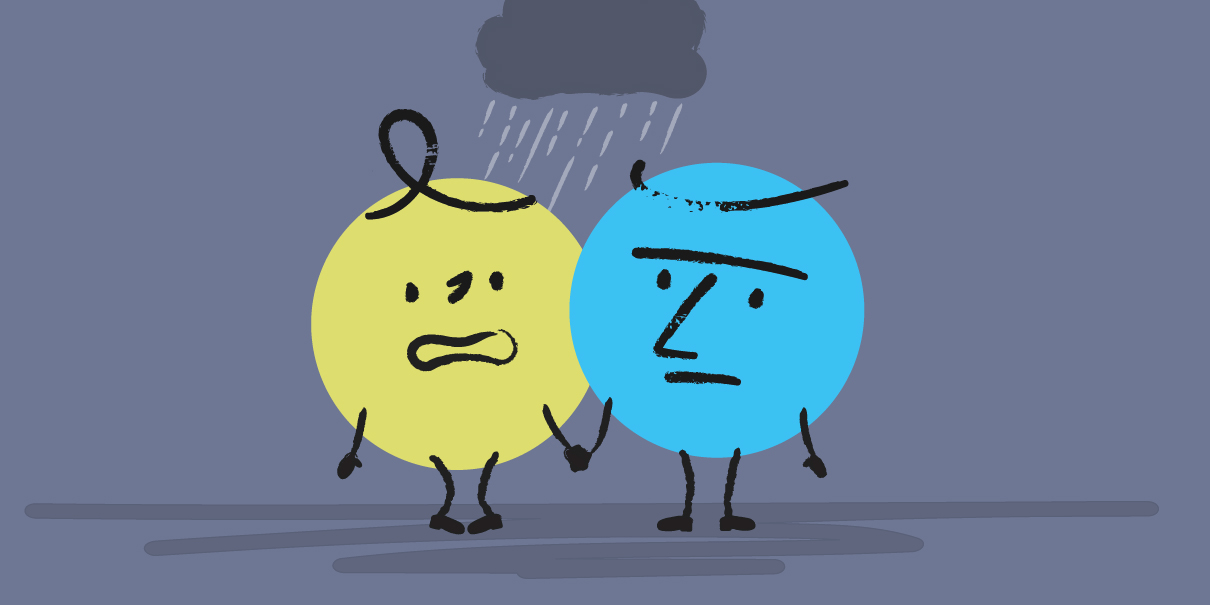 3rd May 2023
3rd May 2023
Why do anxiety and depression love company?
A significant number of people experiencing anxiety will also experience depression, as they are both driven and maintained by similar processes in the brain. The good news is, we can break this cycle and improve our mood and motivation. Read on to find out how!
The anxiety and depression cycle
Both anxiety and depression are driven by the interaction between thoughts, feelings and behaviours. The same thoughts, behaviours and physical sensations that drive anxious thoughts can also contribute to feelings of depression.
For example, we may experience thoughts like “other people think I’m incompetent” or “other people won’t like me.” This may then lead us to experience feelings of depressed mood and anxiety in social situations.
These anxious feelings might then lead us to engage in the behaviour of avoiding social situations. This behaviour reinforces the feeling of anxiety, as we rob ourselves of the opportunity to learn that our anxious thoughts are not true. This causes us to be trapped in a vicious cycle of anxiety and depression.
Mood swings and roundabouts
Withdrawing from social situations can also maintain feelings of depression, due to a lack of connection with others. This can lead to getting stuck in a pattern known as the lethargy cycle, where negative thoughts about ourselves lead to low motivation, causing is to withdraw from activities. This, in turn, creates more negative thoughts - and thus the cycle continues.
When worries and anxiety persist for long enough, it can be hard not to feel down as a result. Similarly, when feelings of low mood and sadness linger, this can contribute to worries about the future.
Thankfully, the skills to help reduce anxiety and depression are similar. There is a way forward if you find yourself caught in feelings of worry and sadness.
Build a road out of the cycle of anxiety and depression
Stepping off the vicious cycle, or ‘roundabout,’ of anxiety and depression involves doing things differently. A helpful place to start is with a new behaviour. Pick an activity that gives you a sense of fun, interest, joy or achievement, or an activity that you have avoided due to fear or anxiety.
Even if you don’t feel like doing the activity, it’s important to follow through with the activity and be curious to see how you feel afterwards. This helps to break the cycle that maintains both anxiety and depression.
For example, you may wish to:
- Listen to your favourite song > can lead to thoughts such as “I forgot how much I like this music, it reminds me of when I went the band’s concert last year and had a great night” > increased motivation to listen to more music
- Go for a short morning walk > can lead to thoughts such as “at first I didn’t feel like getting out of bed, but after going for a walk I feel more calm and relaxed for the day ahead” > improved mood and reduced physical anxiety symptoms
- Call a friend > can lead to thoughts such as “before I called them I was worried they wouldn't want to chat. We ended up having a great catch-up, and made plans together for the weekend” > more balanced thoughts and reduced anxiety
- Start a task you’ve been putting off > “I have been procrastinating starting my assignment because it felt overwhelming, though once I got started and broke down the task it wasn’t as bad as I had expected” > reduced worry and rumination
For ideas on other things to do to improve your mood and reduce anxiety, check out the '100 things to do' resource over at the Wellbeing Space.
Needing a bit of extra support with feelings of depression and anxiety? Check out our free Mixed Depression & Anxiety Course.
*This blog is an adaptation of the original post by our colleagues at This Way Up
